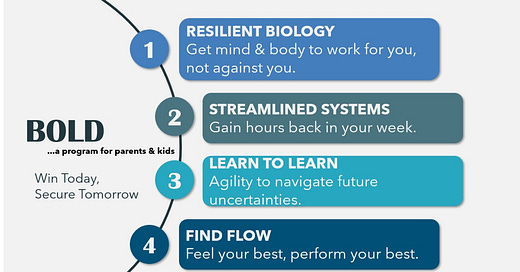When my kids were young, I had those days that felt like lost opportunities. I saw my kids struggling and felt a rock in my gut; maybe I was failing them. I was too busy surviving (i.e., overwhelmed, overworked, under-rested, and chronically stressed) to even think about thriving. I knew when I had blown it, the nights I went to bed crying because I could have made better choices. I felt alone, and as an educator, I thought I should have known all the 'raising kids' answers.
Maybe you get those feelings, too. We are not alone. Most families I work with wonder if they are doing enough for their kids.
I've learned a few things, from raising my kids and working in education with hundreds of other families in and outside schools. I won't pretend to be a parenting expert, just someone who's made many mistakes and has been willing to learn and try something different.
However, let's be clear: there's no right way to parent because we all have different belief systems, so I'll share my experiences and the science I've found, and then you put it all through the filter of your own family.
Learning well doesn't have to be a big mystery. We just haven't bothered to tell parents and kids how it works. It is my goal to remedy that. These are the things I wish someone had told me when I was in the thick of it with my kids. In upcoming posts, we'll go through a simple, four-part model so kids (and parents) are prepared to learn anything.
The goal is for kids (and parents) to find flow when they want it. Flow is the psychological state where we feel our best and learn our best. You might have had a flow experience where you lose track of time because you’re fully engaged in what you’re doing (e.g., reading a book, chatting with a friend, doing a sport.)
We can teach kids to learn in flow, and if kids are anything like the studies done in the business world, learning and working in flow may open the door to increasing productivity by 500% (McKinsey & Company, 2013). Of course, productivity is only one of the things we want for kids. The list is long, but creativity, skill acquisition, and problem-solving are also on that list.
Harvard researchers (Griffith, 2014) continued to measure heightened creativity three days after a flow state. DARPA (2017) found that skill acquisition increased by 490%, and the University of Sydney showed a 430% jump in creative problem-solving. If flow can do this for adults, what might it be able to do for your child, who naturally lives closer to flow because children's brains aren't fully developed.
We’ll find flow step by step, beginning with RESILIENT BIOLOGY, as it’s the foundation for learning and flow. In the upcoming weeks, we'll explore how to help children manage their biology so their bodies work for them, not against them.
In everything I discuss, I've studied the science behind learning, so you can pick up the ball where schools have dropped it. I'll bring together cutting-edge strategies to overcome the challenges you face, whether your child is five years old or fifteen. And…as a bonus…most things you learn here can also be applied to your life.
My goal is for your entire family to have well-being: feeling well, living well, and learning well.
The next few weeks are about sleep because sleep is the door to learning, and parents hold the key.
For those who have just tuned in, we've already talked about another aspect of kid biology: motivation. Feel free to go back and take a peek.
The Three C’s of Intrinsic Motivation
Connection of Meaning: A crisis of meaning
Why why matters: Drifting to driven
Social Connection: Creating community
Choice: Letting kids decide
Competence: Milestones to meltdowns
Putting it Together: Three C’s





